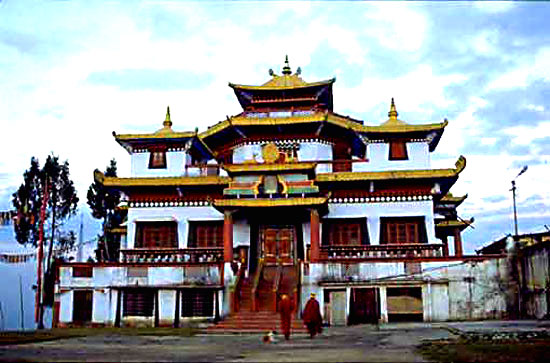
Pemayangtse, an important Buddhist religious center
India Post, March 2, 2009
Pemayangtse, Sikkim (India) — The small town of Pemayangtse is an important Buddhist religious center in the state of Sikkim.
Pemayangtse is not only a religious center, but it offers a panoramic view of the eastern Himalayas to the traveler including the mighty Kanchenjunga peak that overlooks the town. The area around Pemayangtse offers to the adventure seeker a number of trekking and hiking trails.
Pemayangtse is located in the southwestern part of the state of Sikkim, in the northeastern region of India. It is set amongst the Sikkim Himalayas at a height of 6,000 feet above sea level and is near Great Rangit River. The weather in Pemayangtse is alpine. Summers (April-June) are short and mild, while winters are cold (November-February). It experiences monsoon rains between July and September.
Best time to visit
The best time to visit Pemayangtse is between the months of March and May
History
The state of Sikkim was originally the home of the Lepcha tribesmen. In the 15th century, this region saw the migration of Tibetan Buddhist sects. The Nyingamapa sect/order established its base in Sikkim and their religious teachers or Lamas helped establish the Kingdom of Sikkim. The ruler of this kingdom was called the Chogyal. The capital of this kingdom was at Yuksom and later shifted to Rabdentse, both of which are near Pemayangtse.
The kingdom of Sikkim included parts of eastern Nepal, the Chumbi valley (Tibet), Ha valley of Bhutan and foothills of India up to Darjeeling. The kingdom of Sikkim tried to resist the advancing British rule in the 19th century, but the British annexed it in 1849. The power of the Chogyal was thus reduced and Sikkim made a British protectorate. This action of the British infuriated the Tibetans, who had an unsuccessful armed clash with the British. This area became a part of India when India annexed Sikkim in 1975.
Tourists attractions
The Pemayangtse monastery is the main attraction of this small town. It is one of the principal monasteries in the state of Sikkim, as it is the second oldest monastery in the state and was built in 1705. This monastery is the main center of the Nyingamapa sect, which is a tantrik sect established in the 8th century ad. The followers of this sect wear red caps rather than the yellow ones worn by monks in other monasteries.
The walls of this monastery are adorned with traditional frescoes depicting tantrik Buddhist themes. An interesting feature of Pemayangtse monastery is the depiction of sangthopalri or heaven, intricately sculpted on wood by a single monk, which took several years to complete. The monastery also houses a treasure trove of antique carvings.
Near the monastery, one can find traditional austere dwellings of the monks. Pemayangtse is endowed with rich natural beauty, as it is set amongst picturesque mountains, glaciers and has abundant shrubs of the exotic rhododendron. Walks around the town are refreshing and one can explore the sylvan environs of Pemayangtse. Pemayangtse is a base for travelers seeking to explore the exhilarating trekking routes of western Sikkim.
Fairs & Festivals
Pemayangtse is famous for its Buddhist festivals. The festival of Losar marking the Tibetan New Year is celebrated in the month of February/March every year with great fanfare in the Pemayangtse monastery. The traditional religious Kagyat Dance festival, involving mask dancing, is held every month in the monastery.
The gaiety and the rhythm of the mask dance will haunt and enchant the traveler, once he has seen it. How to reach: Pemayangtse does not have an airport or railway station but it is connected by road with other parts of Sikkim. Tourism-of-India.com provides complete information about tourism in Pemayangtse. It also offers various tour packages to make you visit comfortable.
Source India Post




